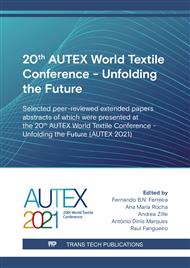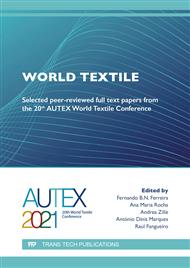[1]
M.-F. Fortin, J. Cotê, and F. Filion, Fundamentos e Etapas do Processo de Investigação. LUSODIDACTA, (2009).
Google Scholar
[2]
J. A. C. Posada, Metodología de la investugación. Fundamentos. Salamanca: Amarú Ediciones, (2001).
Google Scholar
[3]
P. Hannukainen and K. Hölttã-Otto, Identifying Customer Needs: Disabled Persons as Lead Users, in ASME 2006 International Engineering Technical Conferences and Computers and Information in Engineering Conference, (2006), p.243–251.
DOI: 10.1115/detc2006-99043
Google Scholar
[4]
S. Robson and A. Foster, Qualitative Research in Action. London: Edward Arnold, (1989).
Google Scholar
[5]
Guia Prático: Os direitos das pessoas com deficiência em Portugal, GRAFE, (2019).
Google Scholar
[6]
M. Bianchin and A. Nuovo, Just design,, Des. Stud., (2017), p.1–22.
Google Scholar
[7]
J. Sachs, G. Schmidt-Traub, C. Kroll, G. Lafortune, and G. Fuller, Sustainable Development Report: Transformations to achieve the Sustainable Development Goals, New York, (2019).
DOI: 10.1017/9781108992411
Google Scholar
[8]
G. Pullin, Design meets disability. London: Massachusetts Institute of Technology Press, (2009).
Google Scholar
[9]
Information on https://www.who.int/publications/i/item/world-report-on-vision.
Google Scholar
[10]
Information on https://www.acapo.pt/deficiencia-visual/perguntas-e-respostas/deficiencia-visual.
Google Scholar
[11]
Information on https://www.portugaltextil.com/novas-ideias-para-o-futuro/.
Google Scholar
[12]
Information on https://www.acapo.pt/a-inclusao-nao-e-um-ingrediente-e-uma-receita.
Google Scholar
[13]
J. Giacomin, What Is Human Centred Design ?,, Des. J., vol. 6925, (2015).
Google Scholar
[14]
H. Persson, H. Åhman, A. A. Yngling, and J. Gulliksen, Universal design, inclusive design, accessible design, design for all: different concepts—one goal? On the concept of accessibility—historical, methodological and philosophical aspects,, Univers. Access Inf. Soc., vol. 14, no. 4, (2015), p.505–526.
DOI: 10.1007/s10209-014-0358-z
Google Scholar
[15]
F. Moreira and R. Almendra, Inclusive Design : a New Approach To Design Project, in A Portrait of State-of-the-Art Research at the Technical University ofLisbon, Springer, (2007), p.605–621.
DOI: 10.1007/978-1-4020-5690-1_37
Google Scholar
[16]
R. K. Sassaki, Inclusão: Acessibilidade no lazer, trabalho e educação, Rev. Nac. Reabil., (2009), p.10–16.
Google Scholar
[17]
R. Blasco, T. Blanco, A. Marco, A. Berbegal, and R. Casas, Needs identification methodology for inclusive design, Behav. Inf. Technol., vol. 35, no. 4, (2016), p.304–318.
DOI: 10.1080/0144929x.2016.1149962
Google Scholar
[18]
K. Bendixen and M. Benktzon, Design for All in Scandinavia - A strong concept, Appl. Ergon., vol. 46, no. PB, (2015), p.248–257.
DOI: 10.1016/j.apergo.2013.03.004
Google Scholar
[19]
A. Kabel, Disability, the senses and apparel: Design considerations, Senses Soc., vol. 11, no. 2, (2016), p.206–210.
DOI: 10.1080/17458927.2016.1196887
Google Scholar
[20]
D. A. Norman, Living with Complexity. (2011).
Google Scholar
[21]
H. Dong, C. McGinley, F. Nickpour, and A. S. Cifter, Designing for designers: Insights into the knowledge users of inclusive design, Appl. Ergon., vol. 46, no. PB, 2015, p.284–29.
DOI: 10.1016/j.apergo.2013.03.003
Google Scholar
[22]
E. Manzini, New design knowledge, Des. Stud., vol. 30, no. 1, 2009, p.4–12.
Google Scholar
[23]
J. Clarkson, R. Coleman, I. Hosking, and S. Waller, Inclusive design toolkit, Cambridge: University of Cambridge, (2007).
Google Scholar
[24]
J. Park, K. Morris, C. Stannard, and W. Hamilton, Design for Many, Design for Me: Universal Design for Apparel Products, Des. J., vol. 17, no. 2, 2014, p.267–290.
DOI: 10.2752/175630614x13915240576103
Google Scholar
[25]
S. Sinek, Start With Why. USA, Portfolio, (2009).
Google Scholar
[26]
Information on https://www.businessoffashion.com/articles/news-analysis/fashions-long-road-to-inclusivity.
Google Scholar
[27]
Y. Kawamura, Fashion-ology: Dress, Body, Culture. Oxford, NY: Berg Publishers, (2005).
Google Scholar
[28]
Pina, L., Lucas, J., Duarte, P., Martins, P., & Miguel, R, Fashion for Visually Impaired Consumers: A Case Study Towards Inclusive Products, in: D. Raposo, J. Silva, R. Dias, J. Neves, & L. Castilho (Eds.), Advances in Design, Music and Arts: 7th Meeting of Research in Music, Arts and Design, Springer, Castelo Branco, 2020, p.311–329.
DOI: 10.1007/978-3-030-55700-3_22
Google Scholar
[29]
Information on https://www.businessoffashion.com/videos/news-analysis/its-time-for-adaptive-fashion.
Google Scholar
[30]
Information on https://www.forbes.com/sites/deborahweinswig/2018/04/23/adaptive-clothing-designers-are-innovating-like-amazon-by-putting-the-customer-first/.
Google Scholar



